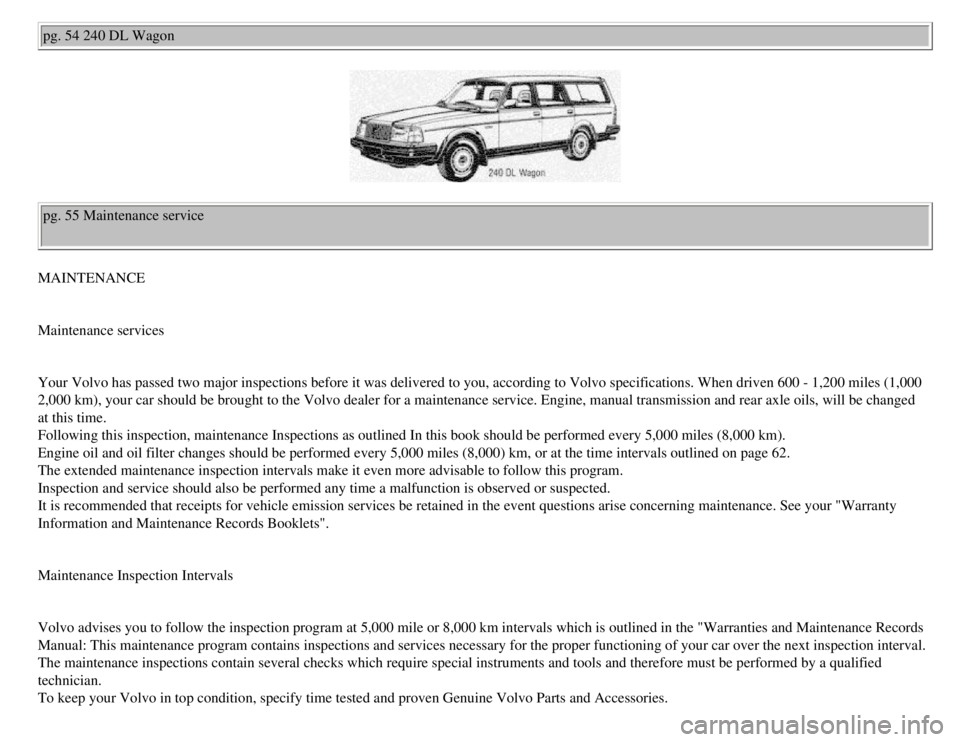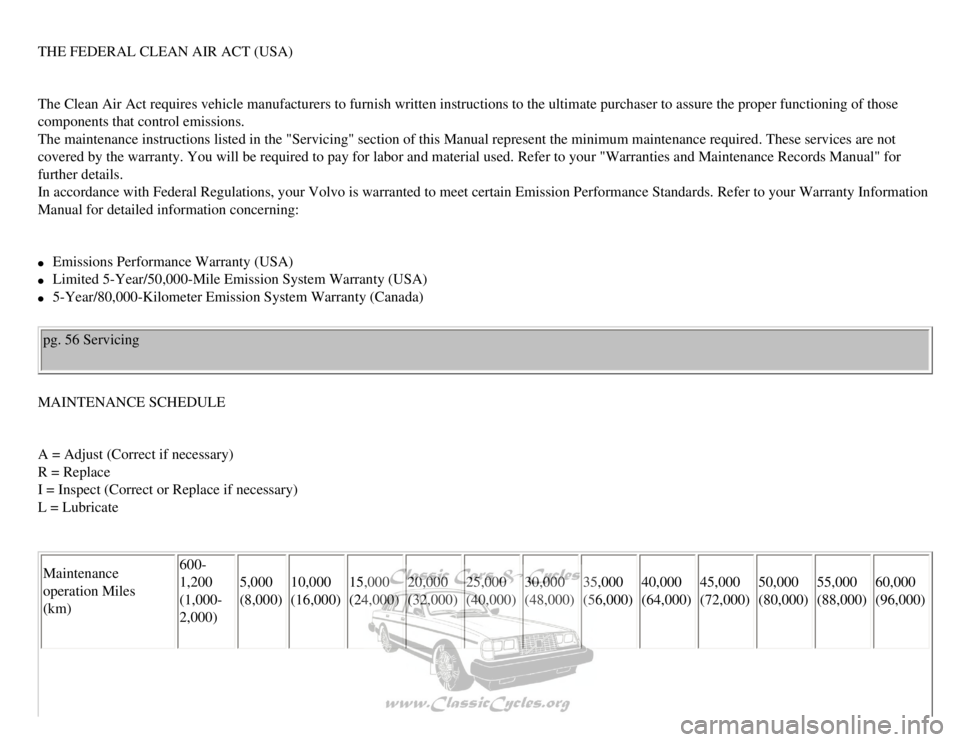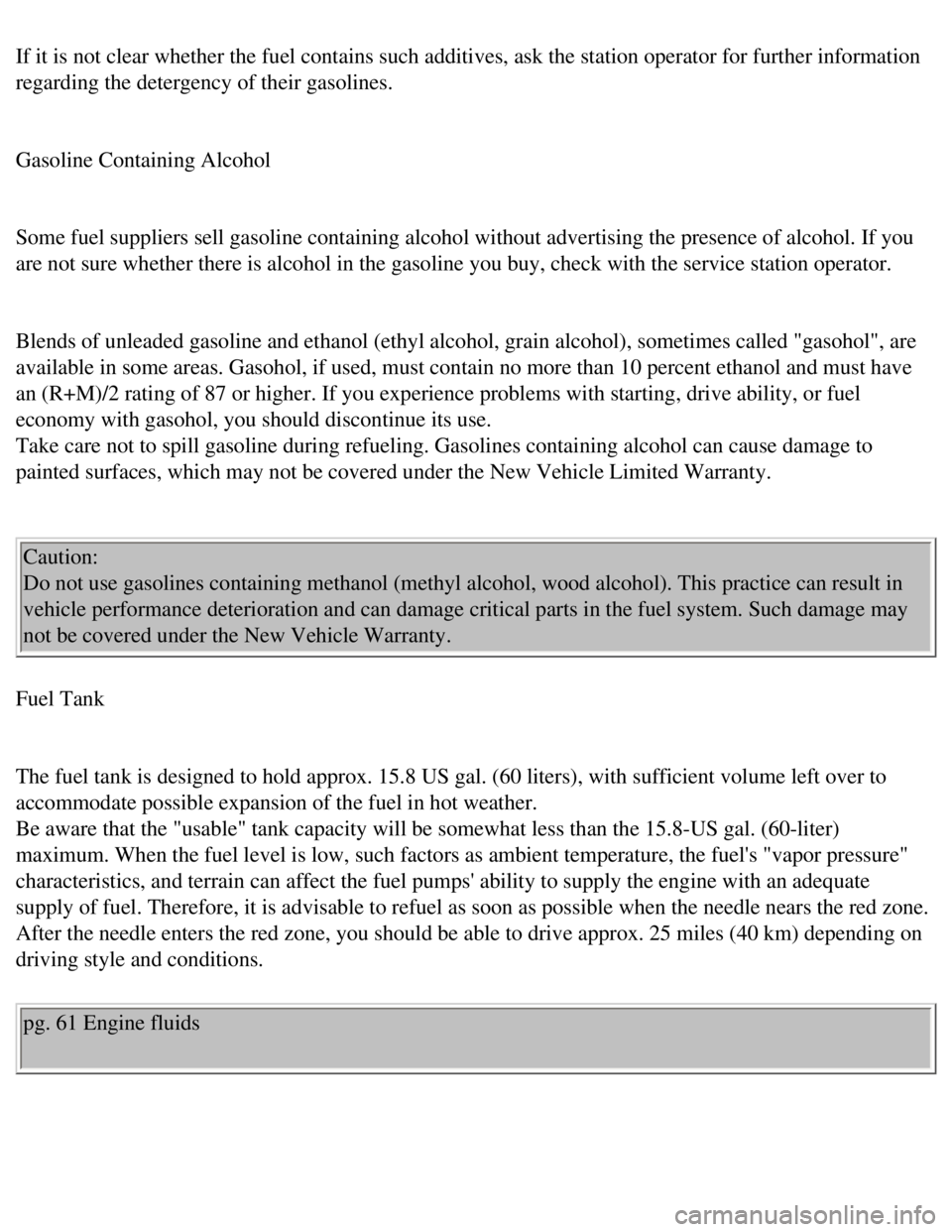Page 51 of 143
Volvo 1990 240 Model
pg. 41 Operating the car
42Service inspection
42Break-in period
43Driving economy, shift indicator light
44Starting the engine
45Manual transmission
46Automatic transmission
48Emergency towing
49Towing information
50Trailer hauling
51Automatic transmission, brake system
52Catalytic converter
pg. 42 Break-in period, Service inspection
A new car should be broken-in!
Manual transmission
During the break-in period do not exceed the following speeds*:
First 600 miles (1,000 km)
1st gear 20
mph
(30 km/h)
2nd
gear 30
mph
(50 km/h)
file:///K|/ownersdocs/1990/1990_240/90240_09.htm (1 of 6)12/30/2006 8:\
25:05 AM
Page 53 of 143

Volvo 1990 240 Model
To obtain best parking brake performance, the brake linings should be br\
oken in.
Stop 5-7 times from 30 mph (50 km/h), transmission in neutral, applyin\
g the parking brake with the
release button pressed in during the stop. The force must not lock the r\
ear wheels. If this happens,
release the brake enough to let the wheels rotate. Drive a mile between \
each stop to cool the brakes.
Check for proper parking brake operation.
Note: The brake lights are not illuminated when applying the parking bra\
ke. To warn traffic from
behind it is therefore advisable to depress the brake pedal slightly to \
illuminate the brake lights.
600 - 1,200 mile maintenance service
To ensure proper operation the car should be taken to a Volvo dealer bet\
ween the first 600 - 1,200 miles
(1,000 - 2,000 km) for a maintenance service. The oil in the engine, m\
anual transmission and rear axle
will then be changed. This is very important since the oil rapidly colle\
cts impurities during the break-in
period.
pg. 43 Driving economy, Shift indicator light
Economical driving does not necessarily mean driving slowly
Better driving economy may be obtained by thinking ahead, avoiding rapid\
starts and stops and
adjusting the speed of your vehicle to immediate traffic conditions. Obs\
erve the following rules:
l Bring the engine to normal operating temperature as soon as possible by \
driving with a light foot on
the accelerator pedal instead of allowing the engine to idle for a prolo\
nged period. A cold engine uses
more fuel and is subject to increased wear.
l When possible avoid using the car for driving short distances. This does\
not allow the engine to reach
normal operating temperature.
l Drive carefully and avoid rapid acceleration and hard braking.
l Do not exceed speed limit.
l Avoid carrying unnecessary items (extra load) in the car.
l Check tire pressures regularly (cold tires).
l Remove snow tires when threat of snow or ice has ended.
l Note that roof racks, ski racks, etc., increase air resistance and there\
by fuel consumption.
file:///K|/ownersdocs/1990/1990_240/90240_09.htm (3 of 6)12/30/2006 8:\
25:05 AM
Page 70 of 143
Volvo 1990 240 Model
pg. 53 Service and maintenance
55Maintenance services
56Service requirements
59Engine B230F
60Fuel requirements
61Engine fluids
62Engine oil, Oil/oil filter change interval
63Cooling system
65Servicing
70Transmission oil
72Rear axle, power steering, brake fluid
73Lubrication
74Coolant
75Alternator, jump starting
76Replacing bulbs
81Fuses
82Wheels and tires
84Wheel changing
86Replacing wiper blades
87Washing, cleaning
87Cleaning, anti-rust treatment
88Paint touch-up
90What causes rust
91Long distance trips, cold weather
92Service diagnosis
96Label information
file:///K|/ownersdocs/1990/1990_240/90240_12.htm (1 of 7)12/30/2006 8:\
25:07 AM
Page 71 of 143

Volvo 1990 240 Model
pg. 54 240 DL Wagon
pg. 55 Maintenance service
MAINTENANCE
Maintenance services
Your Volvo has passed two major inspections before it was delivered to y\
ou, according to Volvo specifications. When driven 600 - 1,200 miles (1,000
2,000 km), your car should be brought to the Volvo dealer for a mainten\
ance service. Engine, manual transmission and rear axle oils, will be changed
at this time.
Following this inspection, maintenance Inspections as outlined In this b\
ook should be performed every 5,000 miles (8,000 km).
Engine oil and oil filter changes should be performed every 5,000 miles \
(8,000) km, or at the time intervals outlined on page 62.
The extended maintenance inspection intervals make it even more advisabl\
e to follow this program.
Inspection and service should also be performed any time a malfunction i\
s observed or suspected.
It is recommended that receipts for vehicle emission services be retaine\
d in the event questions arise concerning maintenance. See your "Warranty
Information and Maintenance Records Booklets".
Maintenance Inspection Intervals
Volvo advises you to follow the inspection program at 5,000 mile or 8,00\
0 km intervals which is outlined in the "Warranties and Maintenance Records
Manual: This maintenance program contains inspections and services neces\
sary for the proper functioning of your car over the next inspection interval.
The maintenance inspections contain several checks which require special\
instruments and tools and therefore must be performed by a qualified
technician.
To keep your Volvo in top condition, specify time tested and proven Genu\
ine Volvo Parts and Accessories.
file:///K|/ownersdocs/1990/1990_240/90240_12.htm (2 of 7)12/30/2006 8:\
25:07 AM
Page 72 of 143

Volvo 1990 240 Model
THE FEDERAL CLEAN AIR ACT (USA)
The Clean Air Act requires vehicle manufacturers to furnish written inst\
ructions to the ultimate purchaser to assure the proper functioning of those
components that control emissions.
The maintenance instructions listed in the "Servicing" section of this M\
anual represent the minimum maintenance required. These services are not
covered by the warranty. You will be required to pay for labor and mater\
ial used. Refer to your "Warranties and Maintenance Records Manual" for
further details.
In accordance with Federal Regulations, your Volvo is warranted to meet \
certain Emission Performance Standards. Refer to your Warranty Information
Manual for detailed information concerning:
l Emissions Performance Warranty (USA)
l Limited 5-Year/50,000-Mile Emission System Warranty (USA)
l 5-Year/80,000-Kilometer Emission System Warranty (Canada)
pg. 56 Servicing
MAINTENANCE SCHEDULE
A = Adjust (Correct if necessary)
R = Replace
I = Inspect (Correct or Replace if necessary)
L = Lubricate
Maintenance
operation Miles
(km) 600-
1,200
(1,000-
2,000)
5,000
(8,000)
10,000
(16,000) 15,000
(24,000) 20,000
(32,000) 25,000
(40,000) 30,000
(48,000) 35,000
(56,000) 40,000
(64,000) 45,000
(72,000) 50,000
(80,000) 55,000
(88,000) 60,000
(96,000)
file:///K|/ownersdocs/1990/1990_240/90240_12.htm (3 of 7)12/30/2006 8:\
25:07 AM
Page 74 of 143
Volvo 1990 240 Model
Spark plugs R R
Catalytic converter
mounting bolts. A
Manual transmission
oil R
I I I I I I I I I I I I
Automatic
transmission oil I
I I I R I I I R I I I R
Rear axle oil R I I I I I I I I I I I I
Exhaust system I I I I I I I
1) See section "Engine Oil" for detailed information.
2) For services beyond 60,000 miles (96,000 km), consult your Mainten\
ance Service Chart.
3) Recommended, but not mandatory to maintain Volvo emission warranty. \
4) Does not pertain to B230F/EGR.
5) B230F/EGR inspect every 10,000 mile (16,000 km). pg. 57 Servicing
Maintenance
operation Miles
(km) 600-
1,200
(1,000-
2,000)
5,000
(8,000)
10,000
(16,000) 15,000
(24,000) 20,000
(32,000) 25,000
(40,000) 30,000
(48,000) 35,000
(56,000) 40,000
(64,000) 45,000
(72,000) 50,000
(80,000) 55,000
(88,000) 60,000
(96,000)
MISCELLANEOUS
MAINTENANCE
file:///K|/ownersdocs/1990/1990_240/90240_12.htm (5 of 7)12/30/2006 8:\
25:07 AM
Page 76 of 143
Volvo 1990 240 Model
Trunk, hood hinges
and latches L
L L L L L L
1) For services beyond 60,000 miles (96,000 km), consult your "Mainte\
nance Service Chart".
Contents | Top of Page
file:///K|/ownersdocs/1990/1990_240/90240_12.htm (7 of 7)12/30/2006 8:\
25:07 AM
Page 79 of 143

Volvo 1990 240 Model
If it is not clear whether the fuel contains such additives, ask the sta\
tion operator for further information
regarding the detergency of their gasolines.
Gasoline Containing Alcohol
Some fuel suppliers sell gasoline containing alcohol without advertising\
the presence of alcohol. If you
are not sure whether there is alcohol in the gasoline you buy, check wit\
h the service station operator.
Blends of unleaded gasoline and ethanol (ethyl alcohol, grain alcohol)\
, sometimes called "gasohol", are
available in some areas. Gasohol, if used, must contain no more than 10 \
percent ethanol and must have
an (R+M)/2 rating of 87 or higher. If you experience problems with sta\
rting, drive ability, or fuel
economy with gasohol, you should discontinue its use.
Take care not to spill gasoline during refueling. Gasolines containing a\
lcohol can cause damage to
painted surfaces, which may not be covered under the New Vehicle Limited\
Warranty.
Caution:
Do not use gasolines containing methanol (methyl alcohol, wood alcohol)\
. This practice can result in
vehicle performance deterioration and can damage critical parts in the f\
uel system. Such damage may
not be covered under the New Vehicle Warranty.
Fuel Tank
The fuel tank is designed to hold approx. 15.8 US gal. (60 liters), wi\
th sufficient volume left over to
accommodate possible expansion of the fuel in hot weather.
Be aware that the "usable" tank capacity will be somewhat less than the \
15.8-US gal. (60-liter)
maximum. When the fuel level is low, such factors as ambient temperature\
, the fuel's "vapor pressure"
characteristics, and terrain can affect the fuel pumps' ability to suppl\
y the engine with an adequate
supply of fuel. Therefore, it is advisable to refuel as soon as possible\
when the needle nears the red zone.
After the needle enters the red zone, you should be able to drive approx\
. 25 miles (40 km) depending on
driving style and conditions.
pg. 61 Engine fluids
file:///K|/ownersdocs/1990/1990_240/90240_13.htm (3 of 9)12/30/2006 8:\
25:08 AM